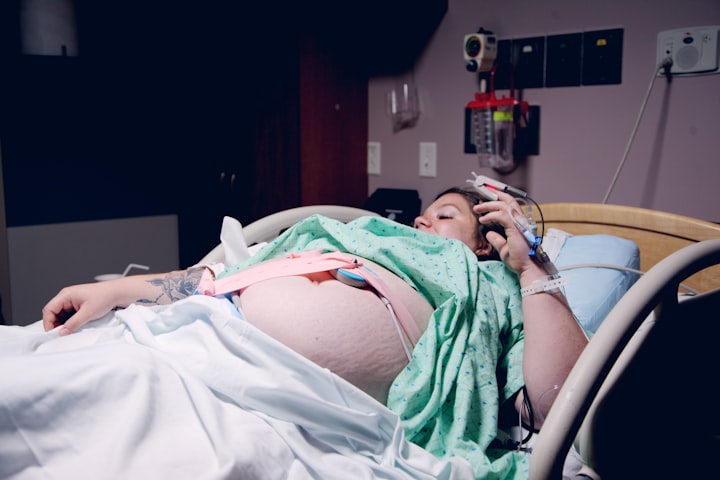Childbirth Myth And Facts
Dispelling Common Misconceptions About Giving Birth

If your water bursts, it implies the baby is on its way, even if merely digesting the placenta is beneficial.
Don't go there. It is a fallacy that labor just takes a few of hours. We'll be busting myths about birthing today. Oh, this is wonderful wide hips mean easier birth. This is a complete lie, because what we see as your hips aren't even representative of what's going on with the bones in your pelvis, which actually important. The bony pelvis is joined by cartilage, which is softer and loosens up towards the latter stage of pregnancy, giving the baby a little more room, and then labor, with all those contractions and coordination that drives the head into the pelvis. A lot relies on the baby, right? I think one thing that frustrates people is when they ask if they will have a vaginal delivery at 38 weeks. We can't tell because there are so many other factors that go into whether or not your baby is coming out vaginally. It's not just the baby's size, it's the baby's position, it's how well the baby tolerates holding its breath every three minutes. the best position to labor and give birth on is your back that's a myth what you might see on television or in the movies of a patient flat on their back is actually the worst position to labor and give birth in we love to have patients be in bed certainly on their side but there's also a lot of opportunity to be sitting up and even to be walking around depending again on the situation with your pregnancy your baby and your labor there's the opportunity potentially to take a shower some people use birthing balls as a place to sit many places now have wireless fetal monitoring where you actually can even monitor the baby while you're moving around and a lot also depends on whether or not you have anesthesia because once you have an epidural it is fabulous for taking away the discomfort on your abdomen and those contractions but it does in many ways weaken your leg muscles so most hospitals will not allow you to walk around with your epidural in just because you may not be as strong this is definitely a myth You can induce labor by eating spicy food, so this is a myth; there are several of them out there; all of the things that people believe you can do to induce labor include pineapples, cream cheese, and other dairy products. That one about rough roads and having sex has some truth to it, right? I know it's not a myth, but nipple stimulation genuinely works. The difficult aspect about nipple stimulation is that you get so many contractions at once that the kid doesn't like it. The sex and nipple stimulation have sort of valid plausible reasons why they may help but I don't think there's a protocol for how to do it and how to do it safely we know how to induce labor we have different medications that we can use vaginally medications that we can use in the iv and we know how to do that safely sex is fine if it's comfortable and something that you want to be doing walking being active kind of getting out and about but i think this baby's gonna come when the baby's gonna come your water breaks with no warning i know people see it in the tv and movies and it's a very dramatic event and it's clear-cut and you rush to the hospital the baby is born that's not always how it happens sometimes it does break with a huge gush and it's very obvious sometimes there's a leak and patients are unsure and sometimes people don't know whether it's urine or it's their water breaking if it's urine it comes out and then it stops and if it's your water it continues it does not stop so put a pad on and if the pad is consistently wet and saturated you have to think gee maybe my water broke sometimes we will break your water for you for some patients they will be in labor and progressing nicely in labor and the water will not have broken on its own if you're unsure whether or not your water is broken it's better to come in and let us tell you yes or no rather than stay at home because if your water has broken and there's a long time before your delivery you do increase the risk for getting an infection if your water breaks that means the baby is coming very soon if only yeah we wish this is not always the case it is all over the map because a lot depends on how many children you've had if it's your fourth baby and you're contracting in your water breaks it's coming fast if it's your first baby your water breaks you're not contracting it could be 12 24 hours so it's hard to know contractions that come consistently with the baby's head against the cervix are what makes the cervix open the cervix has to get to 10 centimeters before you can push so that process is the process of labor if your water breaks in the course of that process great but that doesn't tell us the timing for some subset of our patients the water will break and the patient may not be in labor that happens in probably eight to ten percent of patients so if you think your water is broken you should call your provider and say my water's broken i am contracting or not contracting and when should i come in because that answer is going to vary depending on the circumstances around your pregnancy No, eating your placenta is not beneficial for you. Please, please, please do not consume your placenta. Many patients will inquire about the benefits of ingesting the placenta. While we are completely supportive of doing anything to prevent those issues, I believe we must acknowledge that there is no science behind the placenta being helpful to that. There was actually a recent publication from the American Academy of Pediatrics that outlined some of these less traditional practices surrounding birth, and this one is specifically mentioned in that publication. It is critical to pay attention to your nutrition. your hydration, relaxation when you can with a newborn, and lots of help from family and friends labor usually lasts a couple of hours there are occasionally patients who've had children in the past who start to contract at home and come in and quickly have a birth with us but it is definitely the exception not the rule depends on how many kids you've had labor usually last i'd say 12 to 24 hours is average for your first baby second third way faster thank goodness the labor process has multiple stages and phases the early part of labor can take a fair amount of time some people will start with cramping then the cramping is like unbearable and then they'll realize it's contractions those contractions then are maybe 20 minutes apart and then they're 10 minutes apart and you actually need a lot of contractions that are three minutes apart consistently to soften the cervix and most people will do some of that at home for several hours and then they'll call us and say i think i'm in labor and then we'll say come on in once you get to sort of that six or so centimeters things start to speed up and then you eventually get to you know 10 centimeters and then the real work happens usually you will begin to push shortly after you are determined to be 10 centimeters and then that pushing process is called the second stage of labor and it's from the time that you're fully dilated until the time that your baby is out once the cord is clamped and cut then we go on to the next step which is we need to deliver the placenta we then are going to do some things to help prevent you from bleeding so that's sort of the last piece making sure that we identify and repair tears that were created during the birth process Doctors smacked the infant on the back after birth; this is an ancient wives' tale from the movies. I think it comes from the desire to stimulate the baby to take a big deep breath after we clamp the cord but you don't really have to do that the babies do it on their own they start crying so sometimes you will see us rub the baby's back or tap the bottom of the baby's feet just to sort of make it go up and then it takes deep breath coughs up fluid and then starts screaming an epidural increases the chance of needing a c-section myth epidural does not increase the risk of needing a c-section i think that misinformation comes from the fact that some patients probably get the epidural so early that they're not even in labor and then it becomes intervention after intervention after intervention and some people end up with a c-section they'll explain the risks they'll explain the benefits and they'll explain the alternatives which is always to not have one but the risks that they will talk about are a tiny risk of infection and a very small risk of a headache after the procedure again this is shared decision making at its best it's great to have options for what you're going to use to manage labor because labor is painful get the epidural early before it's too late that's a myth yeah this is a myth but it's a really common one that we hear we wouldn't want you to get an epidural if you're not in labor there really is no too late unless it's that the baby's coming or that you're unable to really sit still for them to place the epidural itself i think it's our job to sort of work with you to figure out when is that just right for you and it may not be the same for every patient if you show up and you're 10 centimeters and you're like i want an epidural i will actually talk you down from that ledge because it's not that you can't get the epidural it takes about 15 minutes to get the effect of the epidural so 15 minutes into your 10 centimeters and pushing your baby might be out by then have the conversation with the anesthesia team even if you're not ready to commit meet the people learn about the risks and benefits before you're in the active phase of labor incredibly uncomfortable when it becomes harder to listen and process information c-sections are the easy way out myth myth If you compare maternal risks associated with vaginal delivery to a c-section, essentially everything is a little bit higher with a c-section and what do I mean by everything you have a greater risk of infection a greater risk of bleeding and a greater risk of having a blood clot after the delivery and the recovery is definitely longer the surgery itself is complicated so we don't wa
we've really moved towards something called delayed cord clamping which means we deliver the baby we place the baby on the patient's abdomen or chest the cord is still connected from the baby's belly button to the placenta that's still in the uterus and there's still blood flow going through that cord and there have been studies showing that there are benefits to not clamping and cutting immediately if you don't have to we keep an eye on the clock we keep an eye on mom and baby and then when the timing is appropriate we'll clamp the cord and either cut it but typically ask you or your support person or whoever else is participating in the birth if they'd like to participate by cutting the cord it's harder than it looks and i do say that often to the support person when i hand them the scissors sometimes it takes more than one snip with the scissor to sort of get through that cord it doesn't hurt the baby that's another question i get all the time doing yoga poses can turn your breech baby have you seen any studies i haven't seen good evidence that it's true if you're asking us is there scientific research to say that downward dog or the flashlight or the voices helps i think the answer would be no i think if you ask us do any of these things hurt i also think the answer is no as long as you can safely do a downward dog and yoga i definitely find patients worried about it when they have an ultrasound at 28 weeks that the baby is breached and they think the answer to that is that's totally normal when you're approaching 37 weeks and then is when we have to start having a conversation about how do we want to handle this breach that's true but there are plenty of times where the baby is breach at 37 weeks you schedule a c- section for 39 weeks and you come in on the day of your c- section and the baby's head down so it happens kids are still moving and still quite active even after 37 weeks knowledge is power thinking about the labor process and the birth process talking to your provider getting a sense of the practice the unit what things are like there are actually really really important to help lead to a really smooth positive birth experience I think that this is where the birth plan is helpful having some knowledge and knowing what you can expect i think just gives you a much better birth experience.
About the Creator
OJO OREOFE
Hi there, My name is Ojo Oreofe. I am a professional writer with over two years of experience creating content for a variety of audiences. I have worked as a freelance writer for multiple publications. In my free time, I enjoy reading.






Comments
There are no comments for this story
Be the first to respond and start the conversation.